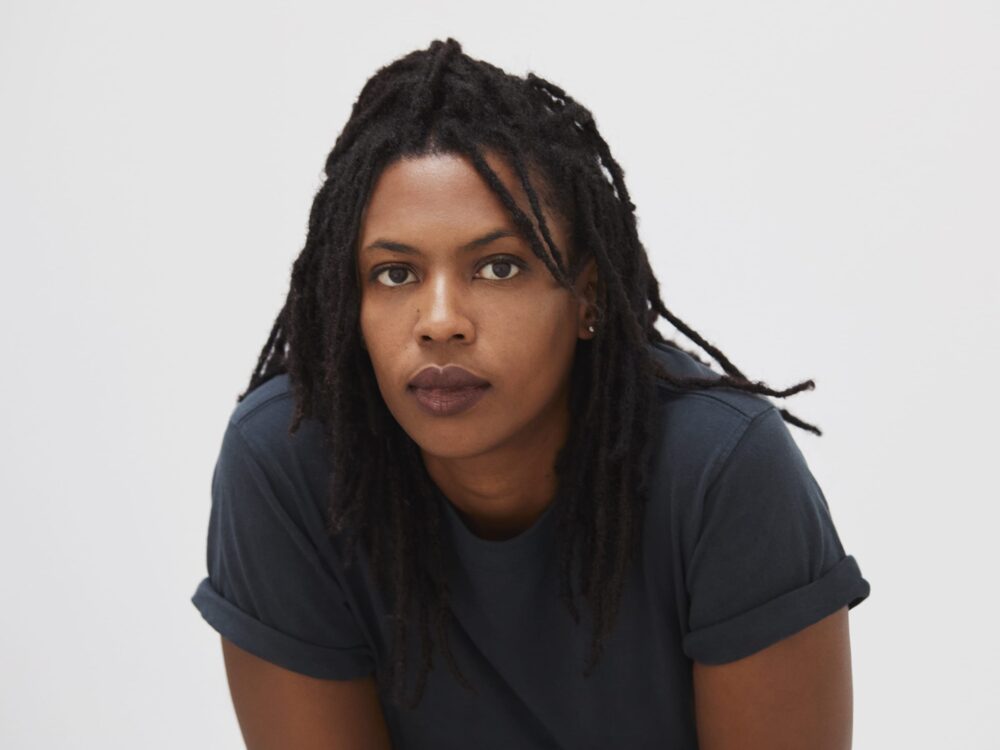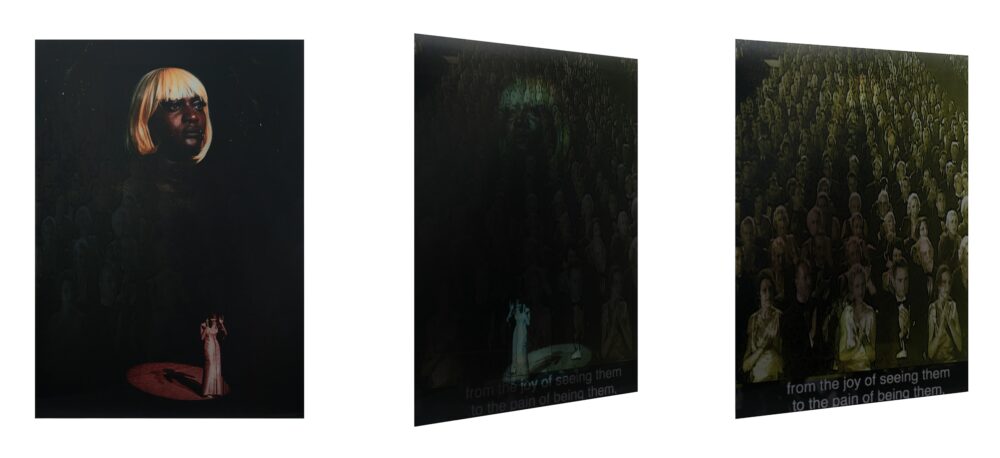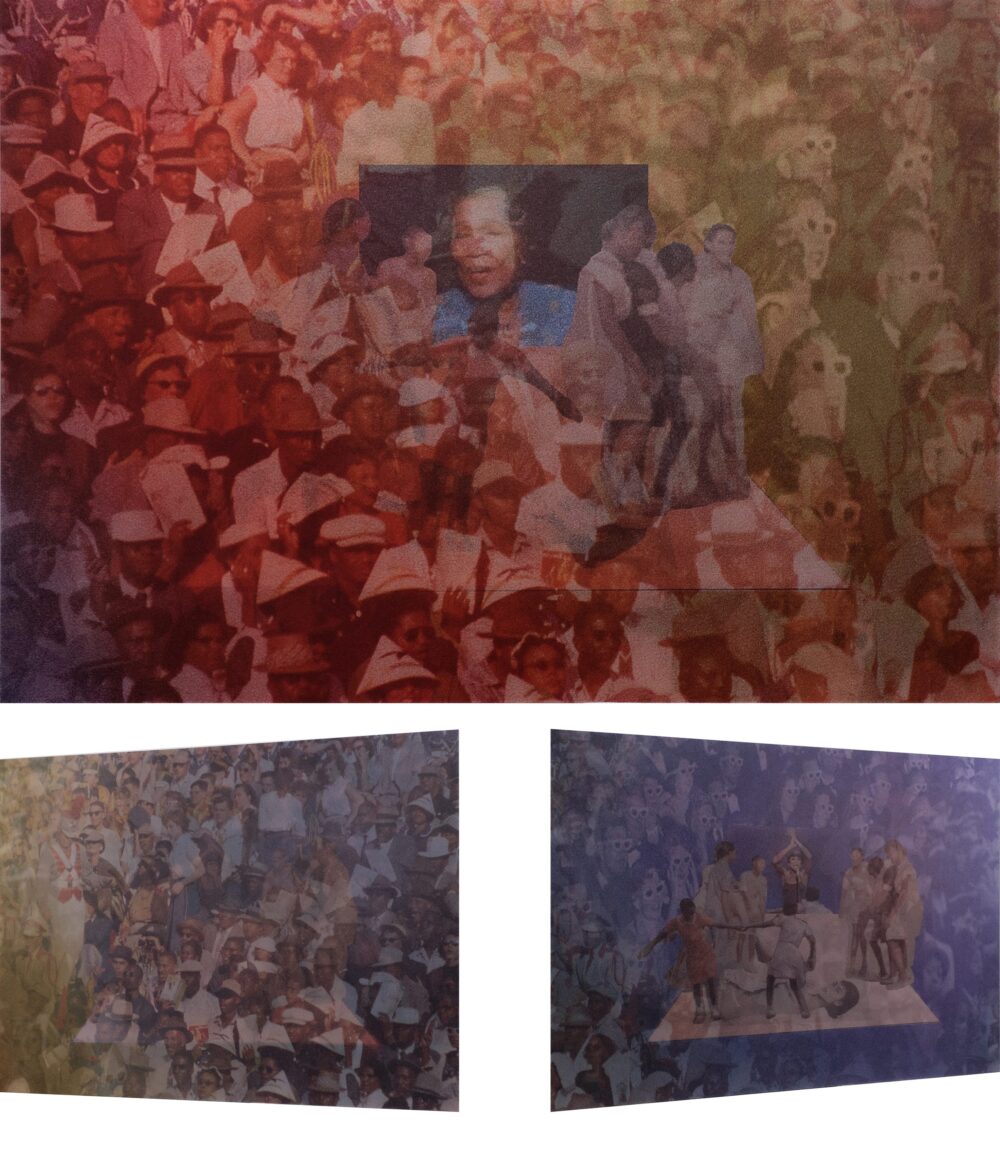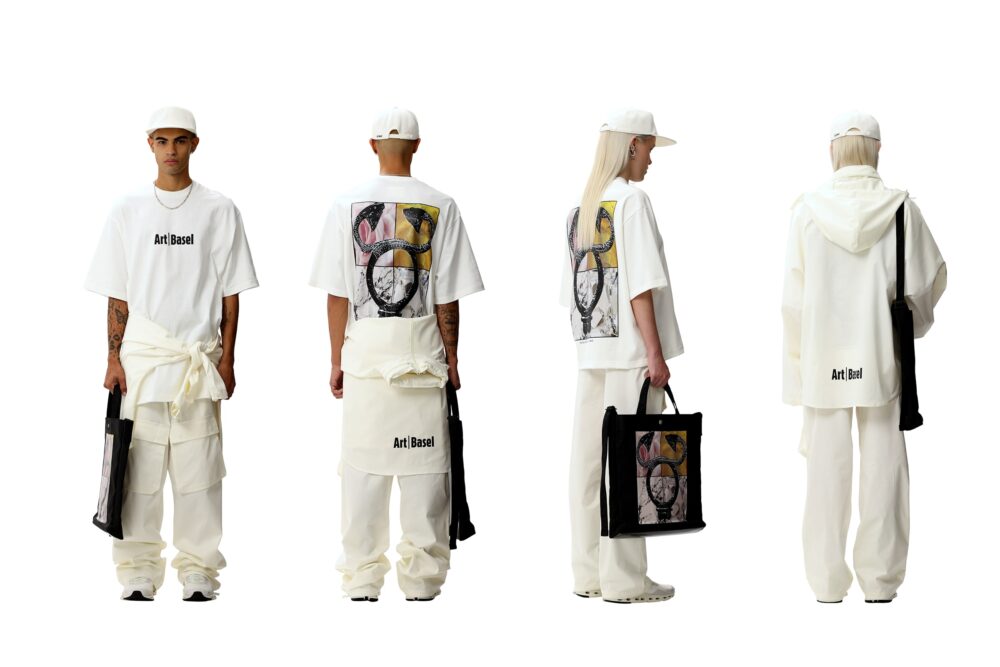
- Source: ART BASEL
- Author: Colony Little
- Date: NOVEMBER 20, 2023
- Format: DIGITAL
Medusa, myth, and transformation: Kandis Williams’s artistic odyssey
Following collaborations with Virgil Abloh and Telfar Clemens, she has turned her hand to designing Art Basel’s new uniforms In partnership with GOAT
Greek mythology is a font of inspiration for Kandis Williams. The Baltimore-born multi-hyphenate artist, writer, and dramaturg uses collage, mixed media, and performance to examine the complex psychological effects of white supremacy that permeate our lived experiences. Her first publishing enterprise, Cassandra Press, is based on the Trojan princess who was graced with the gift of prophecy, only to have her power rendered useless by a curse that forced others to disregard the veracity of her vision. Cassandra Press has distributed lo-fi, Xeroxed readers to audiences outside the hallowed halls of academia, fulfilling a need for informed social critique during a period of intense global turmoil. Now Williams is embarking on a new path. Inspired by Medusa, one of the three Gorgons of Greek mythology, she has collaborated on a uniform for Art Basel show hosts that will be launched at Art Basel Miami Beach 2023 and worn at its global fairs over the next year. The pieces have been designed by the luxury resale platform GOAT and feature Kandis’s artwork in the form of snake iconography and the many guises of the serpent. We talked to Williams about the evolution of her visual art practice and Medusa’s allure as a symbol of transformative catharsis.

Kandis Williams. Photograph by Lelanie Foster.
She created Cassandra Press in 2016 as a site of resistance and an educational platform, issuing more than 50 spiral-bound tomes filled with essays interrogating political and pop-cultural phenomena. With an emphasis on radical, Black, femme voices, these readers provide a contextual framework for her visual art practice while serving as compendiums of critical thought. The mission statement of Cassandra Press is both a validation and a provocation:
‘Our intention is to spread ideas, distribute new language, propagate dialogue centering ethics, aesthetics, femme driven activism, and black scholarship because…y’all ain’t listening.’
This winter Williams is participating in the Brooklyn Museum’s show Copy Machine Manifestos: Artists Who Make Zines. Preparing for it has provided Williams with space to reflect on Cassandra Press and its impact as she winds down this work to make room for other publishing projects. The endeavor’s denouement will coincide with an exhibition on monuments at LAXART in 2025. And now Williams sees a shift in demand that requires an intellectual pivot from awareness to comprehension. ‘I think Cassandra trended through a toxic Greco-Roman revivalism and that the initial energetic demand for the promotion of black scholarship was fulfilled. A deeper, energetic demand is for cognition, and I don’t see that happening.’ In other words, if we weren’t listening then, we aren’t ‘hearing’ now. Another area of Williams’s artistic practice – dramaturgy – facilitated this shift.

Kandis Williams From the Joy of Seeing Them to the Pain of Being Them, 2023.
As a dramaturg, Williams examines the relationship between the artist and the viewer in relation to the expectations of each. Dramaturgs are the contextual linchpins between a production’s concept and its final expression, working with performers and creative directors on the larger cultural and psychological implications of performance. Williams dove into the practice more than 15 years ago in a creative capacity in Berlin, where she now lives. ‘What I get out of dramaturgy is helping other people go from A to B. It is an interrogation of the actual subject, the material, which is the dancer’s body and the stage, or maybe an interrogation of the theater – the site, host, and space. I got to do a lot of guerrilla dramaturgy when I got to Berlin, and it opened up this whole space of people working and doing performances that were not in white cubes that were happening all over the city. We would do screenings and workshops where we could talk through what the live performances were like, what the performances were trying to do, how they were working in theater space.’ Since that first foray into working in the world of theater in this way, Williams has called Germany home, splitting her time between Berlin and Los Angeles and New York.
Her dramaturgy practice extends into other creative industries, including fashion, where she has worked with Virgil Abloh and Telfar Clemens, among others. ‘Something I think about a lot is the will to adorn and how human that is, and how Blackness both enhances and makes weaponizable the will to adorn. While we’re being denied humanity, we’re always being imaged as ultimate specimen of the human. Fashion is a large part of that turn.’
Invariably, much of this work unearths these dichotomies by wrestling with issues around invisibility, power, and agency in systems that view Blackness through a narrow lens while demanding that we reinforce harmful social scripts designed to preserve structures of power. Peeling back these layers is emotional work. ‘It’s funny that I’ve “become” a dramaturg, because most of my work there is never going to be seen, because the work I end up doing around race, class, theater, and gender almost becomes like an art therapy practice, where is feels essential to not go into spaces of dangerous production mechanisms but to ask what themes to the dancer’s interiority, and pause around the question of where virtuosity come from?’
In her visual art practice snakes recur as protective symbols of guardianship. Cassandra is frequently depicted with snakes coiled around her ears, whispering into them, enabling her to hear the future. ‘I understood the serpent as a bringer and a bearer of knowledge, no matter how dangerous that knowledge was framed. I would like to bring her back into my pantheon for protection and for strength.’

From the Joy of Seeing Them to the Pain of Being Them II, 2023.
For this year’s Art Basel Miami Beach, Williams has collaborated with GOAT, the global platform for products from the past, present and future, on apparel inspired by snake iconography, including nests, the caduceus, and the ouroboros. Collaged snake nests are symbols of rebirth, creativity, and transformation; they are also warning signs of danger. With snakes, there’s also a duality within their utility – their venom kills but it is also used as a healing agent. For the coming year, Art Basel hosts will wear uniforms created by GOAT and featuring Williams’s rendition of the caduceus, a symbol frequently used in medicine that has two snakes entwined round a winged staff, representing neutrality, health, and aid. Williams further explores these shape-shifting characteristics in object-related work being presented at the fair by Morán Morán. ‘I’m making lenticular lenses that will express the ambiguity of the snake and the ambiguity of the consumption of Black radical feminism right now being used to stabilize exclusionary practice by so many institutions.’ This concept is echoed in a T-shirt and bag design that riffs on the ouroboros, a serpent consuming its own tail, a herald of ominous symbolism.
Through her visual art, publishing, and dramaturgical work, Williams has gained insights into the performative expectations of artists. Using Medusa as her muse, she’s now diverting that gaze back to the viewer. ‘There’s something in Medusa that I find really powerful, in that she’s framed as a monster, as something to overcome, but essentially she is the hyper object of what it means to be transformed by vision.’ And in that transformation lies another provocation. ‘I’ve been thinking a lot about Medusa and not just looking at something and expecting this reward of seeing something beautiful, but to really look at something and know that you will be changed, that part of you will be hardened, and challenging viewers to accept that as an initial premise for their viewership.’ Embedded within the Medusa narrative is the concept of retreat as an act of self-preservation. ‘This is the Joy James and the “Captive Maternal,” Medusa is about her cave, and the journeys made scores of heroes to conquer her. I think, at the end of the day, I have been informed by so many women older than me, wiser than me. There isn’t enough space in the world yet for our demands to be in the light of day.
‘That’s the mark I’d like to make with Medusa, that neither I nor any other Black feminist or Black woman artists should be used to the point of symbolic self-annihilation. We’re not an infinite matter, we are finite even in the abstract. If you’re going to look at us, if you’re going to direct the gaze at us, be ready to be burdened by that gaze. Be ready to be transformed.’

GOAT x Art Basel.
Kandis Williams is represented by Morán Morán (Los Angeles, Mexico City). She is currently part of the exhibition ‘Copy Machine Manifestos: Artists Who Make Zines’ on view at the Brooklyn Museum through March 31, 2024.
Colony Little is a writer and critic based in Raleigh, North Carolina. She is the founder of Culture Shock Art, a contemporary art blog dedicated to amplifying the voices of Black artists and artists of color. In 2020 she was a recipient of the Andy Warhol Foundation Arts Writers Grant.
Since its founding, GOAT has had the privilege of partnering with inspiring artists and creatives around the world. Its partnership with Art Basel and Kandis Williams extends GOAT’s commitment to the creative community and its vision to inspire individuals to be their greatest selves. Alongside the uniforms, which will be exclusively available to Art Basel hosts, GOAT will debut unique pieces featuring artwork by Williams, available as a part of GOAT’s Winter Campaign where limited apparel drops regularly from November 16 – 24, 2023. Visit Goat’s Black Friday campaign to shop William’s limited edition pieces and more.

